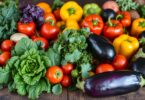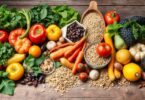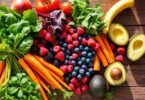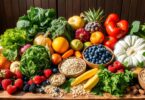
The average American consumes a staggering 4,500 calories daily. This is more than double the recommended amount. It shows how our food choices greatly affect our health and well-being. By making smart choices and adopting a healthy food lifestyle, you can experience vibrant energy, better immune function, and a renewed zest for life.
Welcome to your comprehensive guide to better living through nutritious and delicious food choices. This article will guide you through the basics of nutrition and wellness. You’ll learn about the power of whole foods and get practical tips for clean eating in your daily life.
Key Takeaways
- Discover the essential nutrients your body needs for optimal health and well-being.
- Understand the role of macronutrients and micronutrients in a balanced diet.
- Explore the benefits of incorporating whole, minimally processed foods into your daily meals.
- Learn how to read food labels and make informed, healthy choices.
- Develop strategies for meal planning and preparation to support a sustainable wellness lifestyle.
Understanding the Basics of Nutrition and Wellness
Keeping a balanced diet is essential for our health. At the core is knowing about essential nutrients and their roles. Let’s explore the basics of nutrition and how these elements support our wellness.
Essential Nutrients Your Body Needs Daily
Our bodies need a variety of nutrients to work well. These are split into macronutrients and micronutrients. Macronutrients, like carbs, proteins, and fats, give us energy. Micronutrients, including vitamins and minerals, help with many body functions and health.
The Role of Macronutrients in Your Diet
- Carbohydrates: They are our main energy source, powering our cells and giving us energy for daily tasks.
- Proteins: They help build and repair tissues, crucial for growth, development, and muscle upkeep.
- Fats: Often misunderstood, healthy fats are vital for hormone production, nutrient absorption, and protecting our organs.
Understanding Micronutrients and Their Sources
Micronutrients, like vitamins and minerals, do many important jobs in our bodies. They help our immune system and support bone health. We get these nutrients from a variety of foods, including leafy greens, citrus fruits, whole grains, and lean proteins.
“A balanced diet is the foundation of a healthy lifestyle. By understanding the role of essential nutrients, you can make informed choices to support your overall well-being.”
To achieve optimal nutrition and wellness, eat a variety of nutrient-rich foods every day. Stay with us as we explore the benefits of whole foods and how to succeed with clean eating.
The Power of Whole Foods in Your Daily Diet
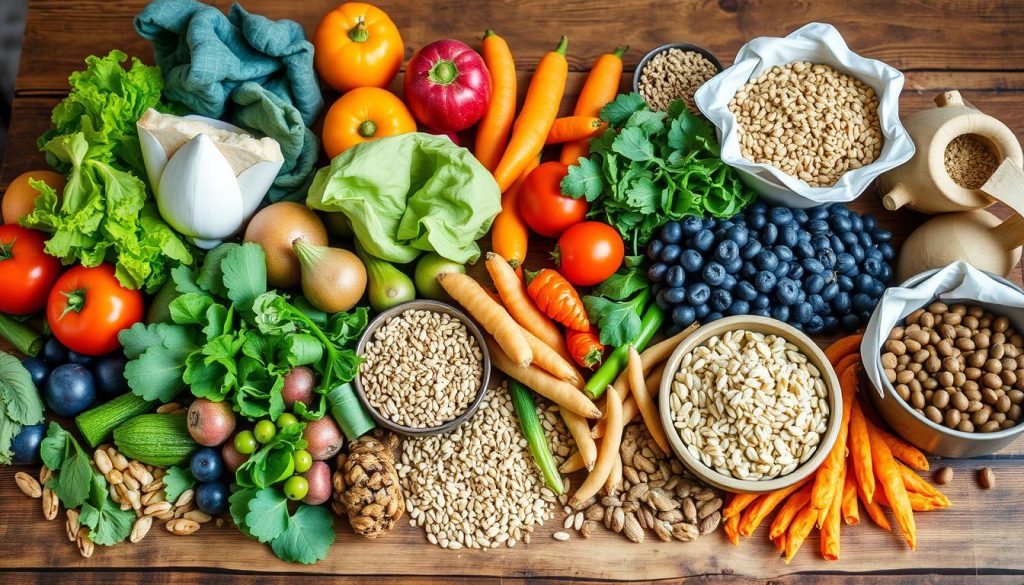
Adopting whole foods can revolutionize your health and well-being. These unprocessed, natural ingredients are rich in essential nutrients. They nourish your body and support optimal function. By adding more whole foods, organic produce, and plant-based options to your diet, you unlock numerous benefits.
Whole foods stand out for their high nutrient density. Unlike processed items, they retain natural vitamins, minerals, and fiber. This means your body gets a wealth of health-promoting compounds, fueling it with the nutrients it needs.
Choosing organic produce boosts the nutritional value of your meals. Organic farming avoids synthetic pesticides and fertilizers. This allows fruits and vegetables to develop their full range of beneficial compounds. Research shows organic produce often has more antioxidants, vitamins, and minerals than conventionally grown options.
Adopting a plant-based diet offers significant advantages. Focusing on whole foods like fruits, vegetables, legumes, and whole grains provides a wide range of nutrients. This can improve heart health, digestion, and even lower the risk of chronic diseases.
Increasing your intake of whole foods, organic produce, and plant-based options can greatly enhance your health. Start by gradually adding these nutrient-rich ingredients to your meals. You’ll soon notice improvements in your energy, vitality, and overall sense of well-being.
Smart Strategies for Clean Eating Success

Embracing a clean eating lifestyle can significantly improve your health and well-being. Yet, achieving clean eating success demands certain strategies. This section will delve into practical tips for navigating towards nutritious and tasty meals.
Reading Food Labels Like a Pro
Understanding food labels is crucial for clean eaters. It’s important to identify key nutrients, avoid hidden sugars, and steer clear of artificial additives. By mastering label reading, you can make choices that align with your health goals.
Kitchen Organization for Healthy Eating
A well-organized kitchen is essential for clean eating. Streamline your space, stock up on necessary healthy cooking tools, and establish a system for easy meal prep. With some planning, your kitchen can become a haven for nutritious cooking.
Meal Prep Fundamentals
Learning to meal prep is key to maintaining a clean eating lifestyle. Set aside time on weekends to plan, shop, and prepare meals for the week. This practice saves time, reduces waste, and ensures access to healthy options at every meal.
By integrating these strategies into your daily life, you’ll be on the path to clean eating success. With commitment and effort, your kitchen can become a center for healthy, delicious, and sustainable meals.
| Meal Prep Tips | Benefits |
|---|---|
| Plan your meals in advance | Saves time and reduces decision fatigue |
| Batch cook and store portions | Ensures you have healthy options on hand |
| Invest in reusable containers | Reduces food waste and single-use packaging |
| Incorporate a variety of fresh produce | Boosts nutrient intake and flavor |
“Meal prepping is a game-changer for healthy eating. It takes the guesswork out of what to eat and ensures you always have a nourishing option at your fingertips.”
Healthy Food: Making Nutritious Choices Simple

In today’s fast-paced world, prioritizing healthy food can be tough. Yet, with a few simple strategies, you can make healthier choices easily. Learn how to navigate the supermarket, restaurants, and your kitchen for quick and easy healthy meals.
At the grocery store, aim for whole, unprocessed foods. Stock up on leafy greens, vibrant produce, lean proteins, and whole grains. Steer clear of processed, high-calorie snacks. Instead, choose nutrient-rich options like nuts, seeds, and fresh fruit.
| Healthy Grocery Staples | Why They Matter |
|---|---|
| Broccoli | High in fiber, vitamins, and antioxidants |
| Salmon | Rich in omega-3 fatty acids for heart health |
| Quinoa | A complete protein and source of complex carbohydrates |
| Greek Yogurt | Packed with protein and probiotics for gut health |
When dining out, look for grilled, baked, or steamed options. Opt for lean proteins and plenty of vegetables. Limit starchy sides and ask for healthier modifications.
At home, focus on quick meals that can be made in 30 minutes or less. Prepare ingredients in advance to make assembling dinners easier on busy nights.
“Healthy eating doesn’t have to be complicated. It’s about making small, sustainable changes that add up to big benefits for your body and mind.”
By making informed choices, you can easily add more healthy food to your diet. A little planning and preparation lead to balanced, nourishing meals without sacrificing convenience or taste.
Superfoods That Pack a Nutritional Punch

In our pursuit of better health and longevity, superfoods stand out as nutritional champions. These ingredients are not just nourishing; they are also rich in essential vitamins, minerals, and antioxidants. Let’s explore the remarkable world of superfoods and how they can boost our wellbeing.
Leafy Greens and Their Benefits
Leafy greens, like kale, spinach, and Swiss chard, are superfood stars. They are loaded with vitamins A, C, and K, along with minerals like calcium and iron. Adding more leafy greens to your diet supports a healthy immune system, strong bones, and may even prevent cancer.
Berries and Antioxidant-Rich Foods
Blueberries, raspberries, and blackberries are antioxidant powerhouses. These fruits are full of compounds that fight free radicals, reducing disease risk and supporting cell health. They also boost brain function and improve skin health.
Ancient Grains and Seeds
Ancient grains and seeds, like quinoa, chia, and flaxseeds, are making a comeback. They are rich in protein, fiber, and healthy fats. These foods help regulate blood sugar, aid digestion, and support heart health.
By embracing superfoods, we can nourish our bodies and enhance our wellbeing. Adding these nutritional powerhouses to our meals and snacks can transform our health and vitality.
Plant-Based Eating for Optimal Health

Adopting a plant-based diet is becoming increasingly popular, offering numerous health benefits. Whether you’re interested in vegetarian, vegan, or flexitarian diets, adding more plant-based foods to your diet can significantly improve your health.
At the heart of a plant-based diet are the vibrant flavors and nutrients found in fruits, vegetables, whole grains, legumes, nuts, and seeds. These foods are rich in essential vitamins, minerals, fiber, and antioxidants. They support the body’s functions and promote optimal health.
The Benefits of Plant-Based Eating
- Reduced risk of chronic diseases, such as heart disease, type 2 diabetes, and certain types of cancer
- Improved digestion and gut health due to the high fiber content
- Increased energy levels and better weight management
- Lower blood pressure and cholesterol levels
- Reduced inflammation throughout the body
Transitioning to a plant-based diet may seem challenging at first. However, the benefits are substantial. With creativity and an open mind, you can discover delicious plant-based recipes that enhance your health.
Embracing a Plant-Based Lifestyle
To begin, focus on adding more plant-based meals to your diet. Try out vegetarian and vegan dishes regularly. Experiment with different plant-based ingredients and find plant-based recipes that you enjoy.
| Nutrient | Plant-Based Sources | Benefits |
|---|---|---|
| Fiber | Whole grains, fruits, vegetables, legumes | Supports digestive health and helps maintain a healthy weight |
| Protein | Tofu, tempeh, lentils, quinoa, nuts, and seeds | Aids in muscle recovery and growth, supports overall body function |
| Vitamins and Minerals | Leafy greens, berries, citrus fruits, bell peppers | Boosts immune function, supports bone health, and promotes energy production |
By embracing a plant-based lifestyle, you open up a world of delicious, nutritious options. This can transform your health and well-being. Explore the possibilities and let your taste buds guide you towards optimal plant-based eating.
Quick and Easy Nutritious Meal Ideas

Keeping a healthy diet can be tough, especially when time is tight. But, with a bit of creativity and quick meal options, you can enjoy tasty, nutritious meals. This doesn’t mean you have to give up your schedule. Let’s look at various breakfast, lunch, and dinner ideas that make healthy living easier.
Breakfast Options Under 15 Minutes
Begin your day with these quick healthy meals ready in under 15 minutes. A nutrient-rich smoothie with fruits, veggies, and protein powder is a great healthy breakfast idea. Try a savory egg scramble with sautéed greens and whole-grain toast for a morning pick-me-up. For something sweeter, overnight oats with fresh berries and honey are perfect.
Lunch Box Heroes
For healthy lunch options, plan ahead and pack meals that are easy to take on the go. A colorful salad with leafy greens, roasted veggies, and lean protein is a great choice. Use whole-grain bread for your sandwich and fill it with grilled chicken, hummus, or avocado. Add fresh fruit or crunchy veggies for a well-rounded lunch.
Dinner Solutions for Busy Families
After a long day, easy healthy dinners are crucial for a nutritious lifestyle. Try one-pan baked salmon with roasted asparagus and quinoa for a quick, nourishing meal. A veggie-packed stir-fry with lean protein and brown rice is also flavorful and filling. For busy families, make a big batch of soup or chili that reheats well all week.
By adding these quick healthy meals, healthy breakfast ideas, healthy lunch options, and easy healthy dinners to your routine, you can enjoy nutritious meals without losing time. Embrace the benefits of wholesome, time-saving meals to improve your well-being.
Smart Snacking for Sustained Energy
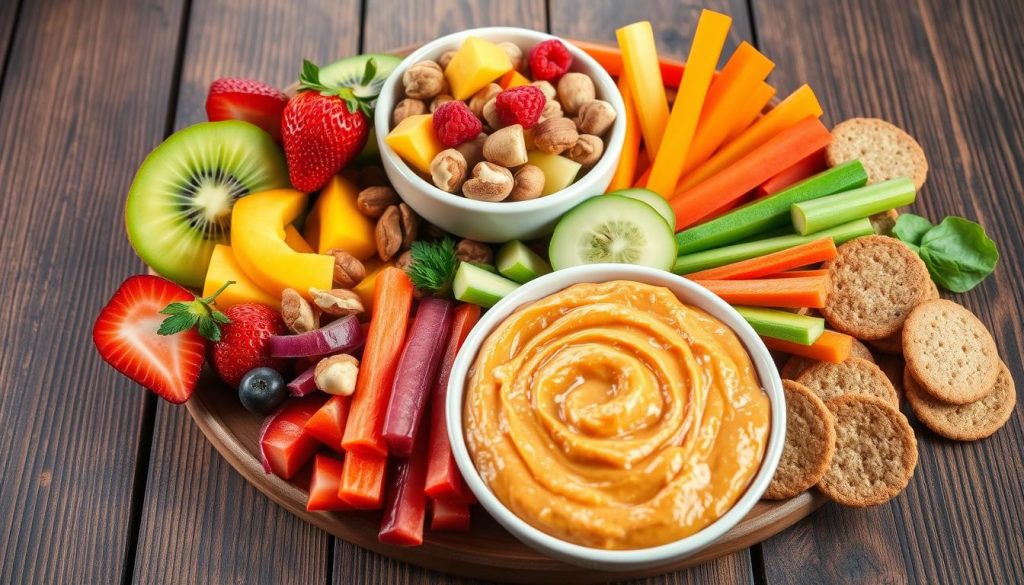
In today’s fast-paced world, it’s common to grab unhealthy snacks for a quick energy boost. Yet, these snacks often leave us feeling drained soon after. By choosing wisely, you can enjoy healthy snacks that satisfy your cravings and provide sustained energy all day.
The Power of Protein-Rich Snacks
Smart snacking involves focusing on protein-rich snacks to stabilize blood sugar and keep you full longer. Greek yogurt with berries, hard-boiled eggs, or nut butters with apple slices are excellent choices. Almonds or cashews also offer a protein-packed snack.
Embrace Low-Calorie, Energy-Boosting Foods
Choosing low-calorie foods is key, but it’s equally important to pick snacks that boost energy steadily. Carrots with hummus, celery with cream cheese, or a small bowl of oatmeal are great options. They fuel your day without derailing your health goals.
| Healthy Snack | Nutrition Profile | Benefits |
|---|---|---|
| Greek Yogurt with Berries | Protein, Fiber, Antioxidants | Supports muscle recovery, boosts immune function, and provides sustained energy |
| Nut Butter on Whole Grain Toast | Healthy Fats, Protein, Fiber | Promotes feelings of fullness, helps maintain blood sugar levels, and offers a nutrient-dense snack |
| Cucumber Slices with Hummus | Fiber, Vitamins, Minerals | Hydrates the body, provides a crunchy texture, and delivers a nutrient-packed snack |
By making smart snacking choices, you can fuel your body with the right nutrients and maintain consistent energy levels throughout the day. The key to successful snacking is finding a balance between satisfying your cravings and nourishing your body with healthy, energy-boosting foods.
“Snacking is an art, not a science. It’s about finding the right balance between indulgence and nourishment.”
Seasonal Cooking for Maximum Nutrition

Embracing seasonal produce is a key to enhancing meal nutrition. By cooking in sync with nature’s cycles, you enjoy fruits and vegetables at their peak. This ensures maximum freshness and flavor.
Spring and Summer Produce Guide
With longer days and warmer weather, your kitchen becomes a vibrant space. Fill it with spring and summer’s crisp greens and juicy fruits. Add asparagus, spinach, strawberries, and mangoes to your recipes for a nutritional boost.
Fall and Winter Wellness Foods
As leaves change and air cools, explore autumn and winter’s richer produce. Roasted root vegetables, winter squash, and citrus fruits add depth to your meals. Leafy greens like kale and Brussels sprouts bring a comforting warmth.
Seasonal fruits and herbs elevate dish flavor and nutrition, regardless of the season. Use local, in-season ingredients to craft nourishing meals. These dishes celebrate the earth’s bounty.
Mindful Eating Practices for Better Health

In today’s fast-paced world, it’s easy to rush through meals and barely notice what we’re eating. However, embracing mindful eating can have a profound impact on our overall wellness and holistic nutrition. This practice encourages us to be fully present and engaged during each bite. It fosters a deeper connection with the food we consume and the energy it provides our bodies.
One of the key tenets of mindful eating is eating for energy. By slowing down and savoring each morsel, we can better tune in to the natural cues of hunger and satiety. This ensures we nourish our bodies without over-indulging. This mindful approach can also enhance the digestive process, improving nutrient absorption and promoting healthier gut function.
- Engage your senses: Notice the colors, textures, and aromas of your food. This heightened awareness can heighten the enjoyment of each meal.
- Eliminate distractions: Avoid eating in front of the TV, computer, or while scrolling on your phone. Focus solely on the act of eating.
- Savor each bite: Chew slowly, paying attention to the flavors and sensations in your mouth. This can help you feel more satisfied with less.
- Check in with your body: Pause periodically to assess your level of hunger and fullness, adjusting your pace and portions accordingly.
By embracing mindful eating practices, we can cultivate a more balanced relationship with food. This ultimately supports our overall health and well-being.
“The greatest weapon against stress is our ability to choose one thought over another.” – William James
Building a Balanced Plate: Portion Control Guide

Achieving a balanced diet is key to optimal health, but it’s not just about what you eat. It’s also about how much you consume. Portion control is vital in meal planning. It helps you maintain a nutritious intake without over-indulging. In this guide, we’ll explore the art of building a balanced plate and understanding serving sizes to reach your wellness goals.
Understanding Serving Sizes
Knowing the right serving sizes for different food groups is the first step to mastering portion control. Here are some tips to visually estimate portion sizes:
- A serving of protein, such as meat or fish, should be about the size of your palm.
- A serving of grains, like rice or pasta, should be the size of your closed fist.
- A serving of fruits or vegetables should be the size of your cupped hand.
- A serving of dairy, such as cheese or yogurt, should be the size of your thumb.
Creating Nutritionally Balanced Meals
Once you understand serving sizes, it’s time to build a balanced plate. This ensures you’re getting the right mix of portion control, balanced diet, and nutritious meals. Here’s a simple guideline:
- Fill half your plate with colorful fruits and vegetables.
- Allocate a quarter of your plate for lean protein sources.
- Dedicate the remaining quarter to whole grains, such as brown rice or quinoa.
- Accompany your meal with a small serving of a healthy fat, like avocado or olive oil.
By following this meal planning approach, you can ensure your meals are both satisfying and nutritionally balanced. This helps you maintain a healthy lifestyle.
Healthy Cooking Techniques and Tips

Embracing healthy cooking methods can greatly boost your meal’s nutritional value and taste. Techniques like steaming and roasting help keep nutrients intact, reducing the need for extra fats or calories. This approach ensures your meals are not only healthy but also flavorful.
Steaming stands out as a versatile method for preserving nutrients. It cooks vegetables, proteins, and grains gently, without soaking them in water. This method retains essential vitamins and minerals. Serve steamed items with homemade dressings, like those made from olive oil, garlic, and herbs, for extra taste.
Roasting is another top choice for enhancing flavors and preserving nutrients. It works wonders on vegetables, chicken, and fish. Roasting at high temperatures caramelizes sugars, creating a crispy exterior while keeping moisture and nutrients inside.
Grilling for Flavor and Nutrition
Grilling offers a smoky, chargrilled flavor that’s hard to beat. It’s a healthy method for cooking proteins and vegetables, as it sears in flavors without needing much fat. Try out different marinades and seasonings to make your meals even more appealing.
For sautéing, use a small amount of healthy oil, such as olive or avocado oil, and cook quickly over high heat. This method helps keep nutrients in while adding rich flavors to your dishes.
| Cooking Technique | Benefits |
|---|---|
| Steaming | Preserves nutrients, gentle cooking method |
| Roasting | Caramelizes flavors, retains moisture and nutrients |
| Grilling | Imparts smoky, chargrilled taste, minimizes added fats |
| Sautéing | Retains nutrients, adds depth of flavor with minimal oil |
By learning these healthy cooking techniques and making smart ingredient swaps, you can craft meals that are both nutritious and delicious. These meals will not only nourish your body but also satisfy your taste buds.
Sustainable and Eco-Friendly Food Choices

In our quest for a healthier lifestyle, we must consider the environmental impact of our food. Adopting sustainable eating habits nourishes our bodies and supports a greener future. By reducing waste and choosing local, seasonal foods, we positively impact our health and the planet.
Reducing Food Waste
Food waste significantly harms the environment, contributing to a large share of global greenhouse gas emissions. Simple actions in our daily lives can help combat this:
- Plan meals and grocery trips to avoid impulse purchases and reduce excess food.
- Utilize leftovers creatively and find innovative ways to repurpose food scraps.
- Compost food waste whenever possible, turning it into nutrient-rich soil for your garden.
- Support initiatives and organizations that work to recover and redistribute surplus food to those in need.
Choosing Local and Seasonal Products
Choosing locally grown, seasonal produce boosts your local economy and reduces carbon emissions from transportation and storage. Locally sourced organic produce and seasonal products are often more nutritious and flavorful, improving your meal quality and enjoyment.
By making sustainable food choices, we actively contribute to a healthier, more resilient food system. Together, we nourish our bodies, support local communities, and foster a sustainable future.
Conclusion
As we conclude our journey through the world of healthy eating, it’s crucial to remember wellness is a lifelong pursuit. By incorporating the practical tips and strategies you’ve learned, you can start a path towards a healthier lifestyle. This path nourishes both your body and mind.
Embracing a balanced diet rich in nutritious meals, whole foods, and superfoods is key to optimal health. Armed with knowledge of essential nutrients, portion control, and smart cooking techniques, you can make informed choices. These choices support your overall well-being. Remember, small, sustainable changes can lead to significant improvements in your energy levels, weight management, and disease prevention.
As you continue your journey towards a healthier, more vibrant life, stay mindful of your food choices. Listen to your body’s cues and find joy in the process. By prioritizing your wellness, you unlock the door to a future filled with vitality, resilience, and a deeper appreciation for the nourishing power of healthy lifestyle tips, nutritious meals, and a well-balanced wellness approach.
FAQ
What is the importance of a balanced diet?
A balanced diet is essential for overall health and wellness. It includes a variety of nutrient-dense foods. These foods provide the necessary macronutrients and micronutrients for optimal body function. This supports energy levels and immune system function.
How can I incorporate more whole foods into my diet?
Incorporating whole foods like fresh fruits, vegetables, and lean proteins is beneficial. Focus on minimally processed, nutrient-dense options. Replace processed items with whole foods in your meals.
What are some tips for successful meal prepping?
Meal prepping can greatly benefit your health. Plan meals in advance and make large batches of nutrient-rich dishes. Portion meals and store them for easy access. This saves time and ensures healthy options are always available.
How can I make quick, healthy meals on a busy schedule?
Quick, healthy meals are possible even with a busy schedule. Use lean proteins, frozen vegetables, and whole grains. Invest in kitchen appliances like slow cookers. Keep a well-stocked pantry and fridge for easy meal prep.
What are some of the top superfoods I should incorporate into my diet?
Top superfoods include leafy greens, berries, ancient grains, and fatty fish. These foods are rich in vitamins, minerals, and plant compounds. They support overall health and well-being.
How can I make smart snacking choices to keep my energy levels up?
Choose nutrient-dense, protein-rich snacks to maintain energy. Options include Greek yogurt with fruit, hard-boiled eggs, and veggie dips. Avoid sugary snacks that can cause energy crashes.
What are the benefits of eating seasonally?
Eating seasonally offers many benefits. Seasonal produce is more nutrient-dense and environmentally sustainable. It requires less transportation and storage. Seasonal ingredients add variety and inspiration to your cooking.
How can I practice mindful eating for better health?
Mindful eating involves being present and attentive during meals. Focus on flavors, textures, and sensations. This approach helps control portions and fosters a balanced relationship with food. Techniques like savoring each bite and avoiding distractions enhance mindful eating.
What are some healthy cooking techniques I should try?
Explore healthy cooking methods like steaming, roasting, grilling, and sautéing. These techniques preserve nutrients and enhance flavors without excessive fats or oils. Making your own healthier versions of dressings and condiments also helps control ingredients and sodium.
How can I make more sustainable and eco-friendly food choices?
Adopting sustainable eating habits benefits the environment. Reduce food waste, choose local and seasonal produce, and select organic options when possible. Supporting local farmers and reducing single-use plastics are also eco-friendly choices.

